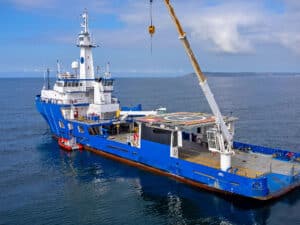
Supreme Court rules on Jones Act seafarer unseaworthiness claims
Written by Marine Log Staff
U.S. Supreme Court (Image: UpstateNYer)
In what’s seen as a big win for Jones Act shipowners, on Monday, June 24, 2019, the U.S. Supreme Court held, in Dutra Group v. Batterton, that punitive damages are not available for a Jones Act seaman’s claim against the vessel owner for breach of the strict liability warranty of seaworthiness of the vessel and its appurtenances.
In a client briefing, law firm Jones Walker notes that, in doing so, the Court ended a decade of uncertainty created by its holding in Atlantic Sounding Co. v. Townsend, 557 U.S. 404 (2009), where it held that punitive damages were not barred for a seaman’s claim that his employer wrongfully withheld maintenance and cure payments. The Court also resolved a split between the Fifth Circuit Court of Appeals, which had ruled in favor of barring punitive damages, and the First and Ninth Circuit Court of Appeals, which had allowed the recovery of punitive damages in unseaworthiness claims.
For years prior to Atlantic Sounding Co. v. Townsend, says Jones Walker, it was largely accepted that punitive damages were not available to Jones Act seamen. After all, even though punitive damages were generally allowed under the maritime law for egregious behavior, most employees are barred from any type of action against their employers. Seamen, on the other hand, are deemed the “wards of the admiralty” and are allowed two different types of tort claims against their employer—the statutory Jones Act negligence claim and the jurisprudential strict liability unseaworthiness claim—and are also allowed to collect a sort of case-law-created quasi-worker’s compensation, maintenance & cure, as well as unearned wages through “the end of the voyage.” Essentially, seamen had the best of both worlds; they could collect quasi-worker’s compensation AND sue their employer in tort.
On top of that, the jurisprudence involving the tort claims allowed seamen has been interpreted very much in favor of the rights of seamen. For instance, although historically an unseaworthiness claim required a seaman to prove the lack of the exercise of due diligence, it was changed into a strict liability claim during the Second World War. Additionally, the general standard of proximate causation applicable in nearly every tort action in common law jurisdictions is tossed aside in favor of the featherweight standard of causation in a Jones Act negligence claim. Comparative fault also differs in that, if the employer violates any safety statute which plays a small part in causing the accident, even though the employee may be severely at fault for his own accident, no comparative fault is assessed to the employee.
Taking all of these legal advantages into account, it seems almost unjust that seamen would also get a punitive damages remedy when similar employees working onshore would receive only worker’s compensation remedies. And in 1990, after the Supreme Court decided Miles v. Apex Marine Corp., 498 U.S. 19 (1990), in which it held that nonpecuniary damages were not available in a Jones Act negligence claim, the issue seemed settled, especially because very few people distinguished unseaworthiness claims from Jones Act claims. In the Gulf South, the issue became a nonissue.
However, in 2008, the Court decided Exxon Shipping Co. v. Baker, 554 U.S. 471 (2008). This case arose out of the infamous 1989 Exxon Valdez oil spill. Of course, the case had nothing to do with the rights of seamen. Importantly, though, although the majority of the opinion focused on the quantum of punitive damages which can be awarded under the maritime law, the case did hold that the jurisprudential general maritime law could be used to supplement the remedies available to claimants under the Clean Water Act.
This holding raised a huge red flag in the minds of plaintiffs’ attorneys and maritime defense attorneys around the country, especially in the Gulf South. The Clean Water Act is a comprehensive series of statutes on which Congress seems to have spoken rather clearly. If the Court would allow maritime case law to supplement that broad statute, why shouldn’t case law be allowed to supplement the Jones Act? More specifically, why shouldn’t nonpecuniary damages—i.e., punitive damages—be allowed for seamen’s tort claims? That’s when the calm waters got very, very choppy.
And the attacks began. Of course, Miles v. Apex Marine Corp. was already a decided opinion, and there was not much plaintiffs’ lawyers could do to get nonpecuniary damages under the Jones Act. So, instead, they began attacking the doctrine of maintenance and cure. This attack proved successful. In 2009, the Court decided Atlantic Sounding Co. v. Townsend and allowed punitive damages for an employer’s wrongful refusal to pay maintenance and cure.
Lawyers were emboldened by this success, and the attacks turned to claims for unseaworthiness. The issue would not find its way to the Supreme Court for another decade, though. In order for certiorari to the Supreme Court to be granted, a split in the decisions of the circuits would be required. That would take time. At the same time, some inventive claimants started asking whether Miles even precluded punitive damages in Jones Act negligence claims. They started to suggest that punitive damages were not barred by Miles because Miles barred only a loss-of-society claim, which was, after all, the only specific claim addressed in Miles; the nonpecuniary “talk” was supposedly only dicta. They also went so far as to suggest that punitive damages were somehow not nonpecuniary.
This time period caused a great deal of uncertainty for attorneys and companies. In 2014, in an en banc decision, the Fifth Circuit decided McBride v. Estis Well Serv., L.L.C., 768 F. 3d 389 (5th Cir. 2014), and held that punitive damages are not recoverable in a seaman’s unseaworthiness claim. This decision eased the tension in the Gulf South and in the offshore oil and gas industry. While the final decision would have to wait for another day, uncertainty and the threat of punitive damages could no longer be used to hold companies hostage in the short run.
This decision also created a split in the circuits. The First Circuit had ruled in 1994 that punitive damages should be allowed in claims for unseaworthiness. Yet until the Ninth Circuit decided Batterton in 2018, allowing for punitive damages in unseaworthiness claims, the Court did not see the issue as worthy of certiorari. Notwithstanding that, the Court decided to hear the issue in 2018 and ruled on the matter on June 24, 2019.
In ruling on the matter, the Court appeared to follow Baker, Atlantic Sounding, and Miles. The Court conceded that it must look at Jones Act negligence claims, unseaworthiness claims, and maintenance and cure claims individually in their own historical context. The Court also conceded that Atlantic Sounding was a slight gloss (the Court refused to say “departure”) over on Miles due to the evidence that punitive damages were historically allowed for wrongful failure to pay maintenance and cure, which, in the Court’s opinion, overrode the nonspecific legislative intent of uniformity they found in Miles to disallow nonpecuniary damages. So the Court determined that if there existed historical evidence of punitive damages being allowed in unseaworthiness claims, then punitive damages could be allowed in unseaworthiness claims, given the current statutory structure. However, this is where the claimant’s argument fell apart. As noted above, there is no strong evidence of a history of punitive damages for unseaworthiness claims. The Court reviewed cases involving the formative years of American jurisprudence on the doctrine of the warranty of seaworthiness, from the Industrial Revolution through the Roaring Twenties, and found no evidence that punitive damages were ever actually awarded. In light of this complete lack of historical evidence of punitive damage awards, the Court held fast to Miles and found that neither legislative intent nor jurisprudential policy required or favored a departure from historical precedent. Therefore, the Court held that punitive damages are not recoverable in a seaman’s claim for unseaworthiness.
Jones Walker says that the Court’s decision has not only made risk easier to calculate; it has, in fact, also eliminated some risk entirely. As such, the decision to try a case or settle a case, and the decision as to the extent of resources to put into any piece of litigation, have become much more manageable risks. There should also be more certainty as to where financial responsibility for those risks ultimately lies.
“All in all,” says Jones Walker, “this is a sound decision that ends a long period of uncertainty. It’s also nice that it helps the good guys.”




